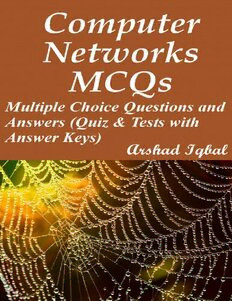
Computer Networks MCQs PDF
Preview Computer Networks MCQs
Computer Networks MCQs Multiple Choice Questions and Answers (Quiz & Tests with Answer Keys) By Arshad Iqbal Table of Contents Chapter 1: Analog Transmission MCQs Chapter 2: Bandwidth Utilization: Multiplexing and Spreading MCQs Chapter 3: Computer Networking MCQs Chapter 4: Congestion Control and Quality of Service MCQs Chapter 5: Connecting LANs, Backbone Networks and Virtual LANs MCQs Chapter 6: Cryptography MCQs Chapter 7: Data and Signals MCQs Chapter 8: Data Communications MCQs Chapter 9: Data Link Control MCQs Chapter 10: Data Transmission: Telephone and Cable Networks MCQs Chapter 11: Digital Transmission MCQs Chapter 12: Domain Name System MCQs Chapter 13: Error Detection and Correction MCQs Chapter 14: Multimedia MCQs Chapter 15: Multiple Access MCQs Chapter 16: Network Layer: Address Mapping, Error Reporting and Multicasting MCQs Chapter 17: Network Layer: Delivery, Forwarding, and Routing MCQs Chapter 18: Network Layer: Internet Protocol MCQs Chapter 19: Network Layer: Logical Addressing MCQs Chapter 20: Network Management: SNMP MCQs Chapter 21: Network Models MCQs Chapter 22: Network Security MCQs Chapter 23: Process to Process Delivery: UDP, TCP and SCTP MCQs Chapter 24: Remote Logging, Electronic Mail and File Transfer MCQs Chapter 25: Security in Internet: IPSec, SSUTLS, PGP, VPN and Firewalls MCQs Chapter 26: SONET MCQs Chapter 27: Switching MCQs Chapter 28: Transmission Media MCQs Chapter 29: Virtual Circuit Networks: Frame Relay and ATM MCQs Chapter 30: Wired LANs: Ethernet MCQs Chapter 31: Wireless LANs MCQs Chapter 32: Wireless WANs: Cellular Telephone and Satellite Networks MCQs Chapter 33: WWW and HTTP MCQs Answer Keys Chapter 1 Analog Transmission Multiple Choice Questions MCQ 1: Multilevel Amplitude Shift Keying (MASK) is not implemented with pure Amplitude Shift Keying (ASK), it is implemented with A. QAM B. PSK C. FSK D. Binary ASK MCQ 2: In a constellation diagram, a signal element type is represented as a A. Dot B. line C. x component D. y component MCQ 3: The term that refers to the phase continues through the boundary of two signal elements is A. non coherent BFSK B. coherent BFSK C. Binary ASK D. Multilevel ASK MCQ 4: The example of an analog to analog conversion is A. radio B. Video C. Television D. internet MCQ 5: The total bandwidth required for Amplitude Modulation (AM) is A. 2B B. 2(1 + β)B. C. 2L D. 2F MCQ 6: The total bandwidth required for AM can be determined from the bandwidth of the audio signal A. BAM = 2B B. BAM = 4B C. BAM = 6B D. BAM = 10B MCQ 7: A constellation diagram can help us to define the signal's A. Frequency and amplitude B. amplitude and phase C. amplitude and frequency D. Frequency and phase MCQ 8: In Multilevel Frequency Shift Keying (MFSK), to send 3 bits at a time we can use A. 2 frequencies B. 4 frequencies C. 8 frequencies D. 10 frequencies MCQ 9: In the case of Phase Modulation (PM), the value of beta (β) is A. Lower B. Greater C. 0 D. Infinity MCQ 10: Analog-to-analog conversion can be accomplished in A. one way B. two ways C. three ways D. four ways MCQ 11: The projection of the point on the X axis defines the peak amplitude of the A. above phase B. below phase C. in phase D. out of phase MCQ 12: Digital information in which the carrier signal is modified by one or more of its characteristics is called A. Demodulation B. Modulation C. Decoding D. Encoding MCQ 13: In BPSK, we use a polar Non Return to Zero (NRZ) signal for A. Decoding B. Encoding C. Modulation D. Demodulation MCQ 14: The Quadrature Amplitude Modulation (QAM) has the same advantages as A. ASK and FSK B. ASK and PSK C. FSK and PSK D. None of above MCQ 15: In Binary Phase Shift Keying (BPSK), there are two values of phase i.e. 0 degree and A. 180° B. 90° C. 360° D. 720° MCQ 16: The value of r in analog transmission is A. log2L B. 2log L C. log L/2 D. Log L MCQ 17: When Amplitude Shift Keying (ASK) is implemented using only two levels then it is called A. Half Duplex ASK B. Multilevel ASK C. Binary ASK D. Duplex ASK MCQ 18: Find the bandwidth for the AM if we need to modulate a 5-KHz voice A. 10 KHz B. 20 KHz C. 30 KHz D. 40 KHz
